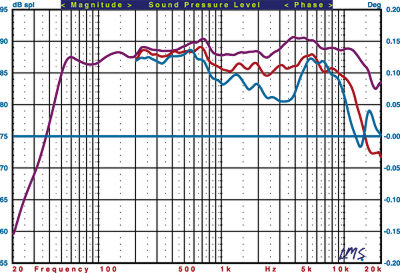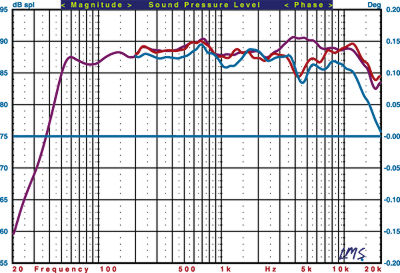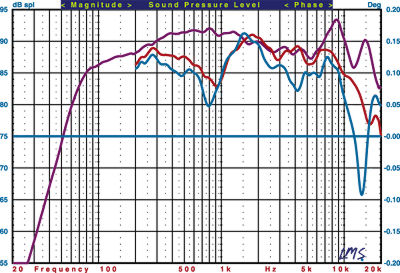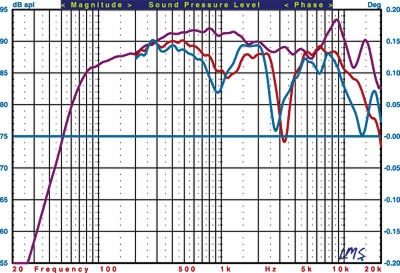Piega P5 LTD surround speaker system Measurements
The tuning of the Piega P5 LTD's ported cabinet is nonstandard. That is, the woofer's response is at a minimum at 26Hz, the port output at a maximum at 56Hz. (In a classically tuned reflex cabinet, both will be at the same frequency.) Judging from the speaker's bass extension, its effective tuning frequency appears to be just below 56Hz. Its minimum impedance magnitude of 2.9? falls at 154Hz. The impedance remains below 4? from 120Hz to 250Hz, with the minimum value of 2.9? at 154Hz. I would rate the nominal impedance at 4?. The impedance phase angle is not extreme, however; while its low impedance in the upper bass makes the P5 a moderately difficult load to drive, any good amplifier capable of driving loads below 4? should be able to handle it. The speaker's sensitivity measured approximately 88dB/W/m.
The pseudo-anechoic response of the P5 at tweeter height, averaged over a 30° forward horizontal angle and combined with the nearfield responses of the woofers and port, is shown in Fig.1 (violet). The bass extends down to about 46Hz (–10dB), though it drops off rapidly below 50Hz. The 30Hz extension in the specification is a little optimistic, but room gain should provide a somewhat stronger low-frequency performance in-room than is suggested by Fig.1. Still, we don't recommend this speaker without a subwoofer in a home-theater system with any ambitions of powerful and extended bass response.

Fig.1
The on-axis response is reasonably smooth. The curve suggests a slightly laid-back quality through the upper midrange and a slightly lightweight quality in the bass and lower mids—again, depending on the room gain. Nevertheless, the measured response is within ±2.5dB across most of the audible range. The response gets a little messier off-axis, though it holds up well up to 45°, and tracks the on-axis average better than most speakers we have measured. The strong dip in the 60° curve suggests limited dispersion of the midrange ribbon at this angle.
Fig.2 again shows the P5's averaged horizontal front response (violet), plus the vertical responses taken at +15° (red) and –15° (blue) relative to the tweeter. There's a noticeable dip from 4kHz to 5kHz both above and below the tweeter, which could well relate to the design goals MF discusses in his review.

Fig.2
As with the P5, the cabinet of the P4 C Mk.II center-channel speaker is tuned in a nonstandard fashion, but the impedance plot indicates a tuning frequency of 60Hz, with a minimum impedance magnitude of 4.1? at 270Hz. A fair rating for the nominal impedance would be 5?, and any good amplifier should be able to drive the speaker. A few ripples in the impedance plot between 800 and 900Hz indicate possible resonances in this region, but MF noted no audible problems there. The P4 C's sensitivity measured approximately 90dB/W/m.
The P4 C's measured front horizontal response, taken on the tweeter axis and averaged in the same manner as described above for the P5, is shown in Fig.3L (violet). The effective bass extension is approximately 63Hz (–10dB). The plot shows a lightweight bass that, like the P5's, should be filled out by a subwoofer, plus a noticeable peak at just under 9kHz that is very different from the P5's response—a little disappointing, since both use the same tweeter. The 45° and 60° curves shown in Fig.3L were taken off-axis to the left of the speaker. The layout of the drivers, and how they're crossed over, mean that the off-axis performance will differ in the opposite direction.

Fig.3L
Fig.3R shows the off-axis response to the right of the tweeter. It's different from Fig.3L, and arguably worse. With many center-channel speakers having two horizontally mounted woofers, we get a dip somewhere in the midrange due to the interference of the two drivers. But when one woofer is limited to 150Hz, that interference shouldn't happen, as MF notes in his review. Here, as we can see, it does.

Fig.3R
The sound of a center-channel speaker with the sort of off-axis performance we see here will be strongly dependent on both the room and the listener's position relative to the tweeter axis. In other words, the room response of such a speaker is more room-dependent than that of a speaker with smoother, flatter off-axis performance. MF was happy with the P4 C's performance, but he sits within the 30° front-axis response cone. His center speaker is also positioned where it is largely free of the sidewall reflections that might have caused the erratic off-axis response seen in Figs.3L and 3R to contribute more to the speaker's overall sound.
However, the P4 C's ±15° vertical off-axis performance (not shown) is excellent, deviating no more than 2dB from the on-axis average up to 12kHz.
These are good though not outstanding results. The main concern is the off-axis performance of the P4 C Mk.II center-channel. A more elaborate, 3-way design, perhaps incorporating Piega's full midrange/tweeter ribbon array configured vertically between the two woofers, would, I feel, better complement the performance of the superb P5 LTD.—Thomas J. Norton





























































